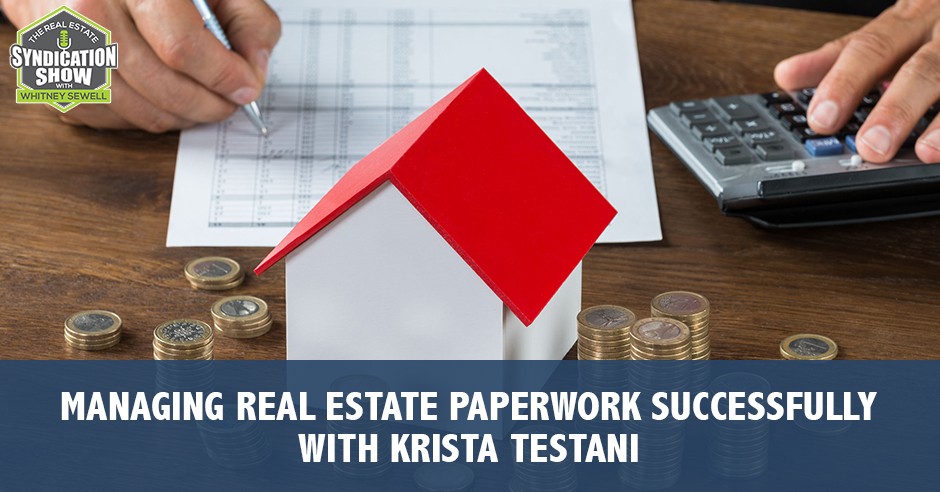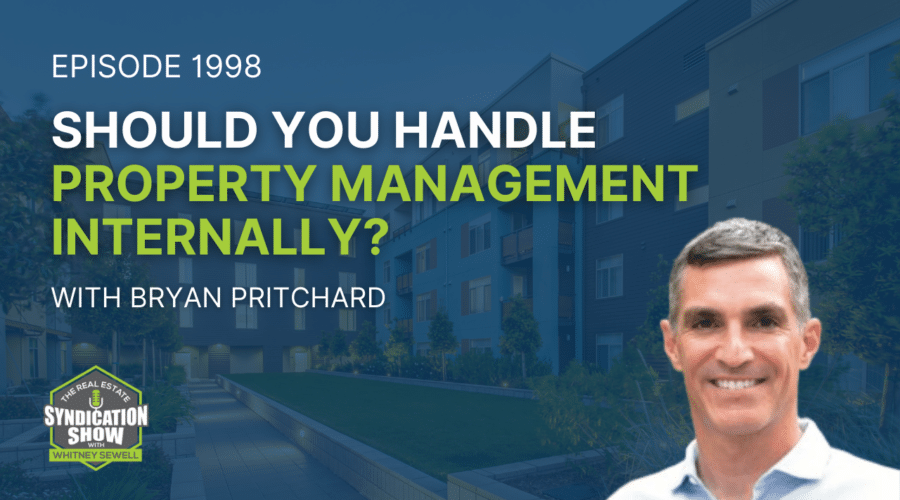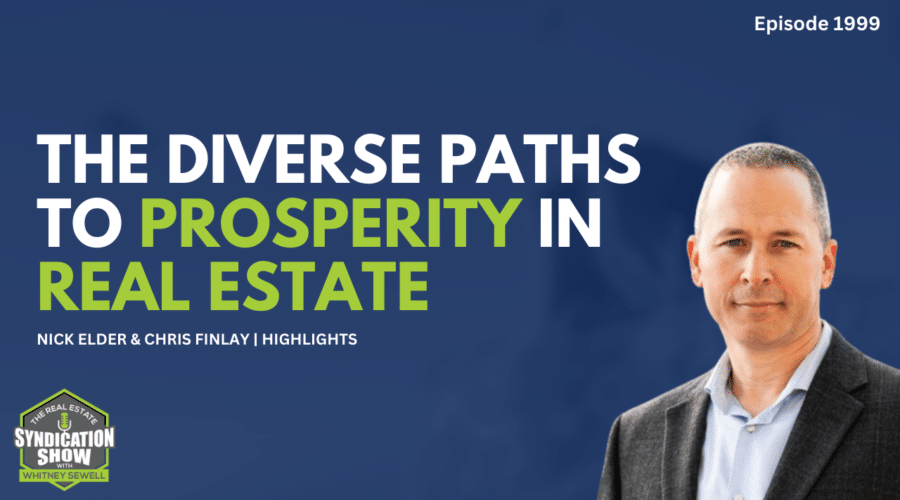Listen to the podcast here:
Managing real estate paperwork and documentation are probably the most tedious parts of any real estate deal. Krista Testani, the Principal and Managing Partner at Sharpline Equity, shares how she evolved from law, to syndication, and then to multi-family. She walks us through what she does as a partner in her business – managing paperwork, understanding documents, and systemizing everything in her office. For anyone who wants to be in multi-family business, Krista outlines the necessary when doing deals, including operating agreements and disclosures. It is ideal, especially when syndicating all over the country, to use a format where you can go online and get the client’s documentation.
Our Gracious Sponsor:
Are you wanting to learn how to gain financial freedom through having your own syndication business? Text LEARN to 474747 to begin to learn from one of the best in the industry, Vinney Chopra. Vinney came to the US with only $7 in his pocket, and now controls hundreds of millions of dollars of real estate he has acquired through multifamily syndication. He is now personally coaching others to do the same. Text LEARN to 474747 to begin your journey to starting your own syndication business! Vinneychopra.com
—
Watch the episode here:
Listen to the podcast here:
Managing Real Estate Paperwork Successfully with Krista Testani
Our guest is Krista Testani. Thanks for being on the show again, Krista.
Thank you for having me again.
I’m pleased to have you back. During the other episode that you are on, WS236, you’ve covered a lot of ground. There was one thing that you briefly mentioned. It’s the importance of managing client relations and that paperwork process. It’s a big process. It’s hard in the beginning to learn some of that. I’ll give a little more about your background and let you elaborate again. Krista’s a lawyer by trade and she transitioned into real estate in 2009 to find singles. In 2012, she started buying multifamily. She’s been involved in acquisitions on the East Coast, including Alabama, Tennessee, Georgia and New York, amounting to over $21 million. She owns an asset and manages 230 units in Atlanta and 40 single-family portfolios in Syracuse, New York. She’s a Cofounder of Multifamily Apartment Investing Unveiled, a networking platform where she and her partners dive into the details of their experiences and share all of their most critical learning moments. Krista, give the readers a little more about your background. Also, I would tell the readers to go back to episode 236 where you can hear more about Krista. Tell them a little bit more about who you are, in case they haven’t heard that one yet.
I am a lawyer by trade. I practiced that for a number of years, but I did give that up in 2007. It was an industry that required an absorbent amount of time. At that time, I realized I didn’t have a passion for it. I wanted to do something that I was passionate about. If you’re going to work X amount of hours a week away from your family and not with your kids, you’d better be passionate about what you’re doing. It took me some time to figure it out. I left in 2007. I started real estate in 2009 by flipping houses and transitioned over to multifamily acquisitions in 2012. That transition is when I started syndication because I realized I wanted to scale my business. It’s why I went into multi-family. You’re not going to do that by using your own money. You need to utilize other people’s money. Syndication was something I did right out of the door day one with my first multifamily deal.
In the day-to-day activity that you’re doing, you sometimes can forget how important the investor is. Without their money, you don’t have a syndication model and a business. It’s not just important to be transparent and communicate well with your performance and communication with your investors as you’re ramping up to get the deal. It’s almost even more important to keep up that level of communication and transparency during the entire life of the hold because you want that investor for your next deal. Maybe you want that investor for another deal while they’re still in this deal. The only way you’re going to continue to win them over is by being transparent and communicating with them often.
There’s a lot of paperwork involved for the ramp up. There’s even more paperwork involved when you’re closing the deal. You have the paperwork involved when you’re communicating with your investors during the hold and helping them file their taxes. It’s a big part of the business that I don’t hear a lot of people talking about because you can consider it back-office stuff. People want to talk about the sexy part of multifamily investing. Those are finding the deals, underwriting the deals, broker relationships and investor presentations. That could be the real fun part of this business. Managing paperwork isn’t the fun part, but it’s super important that you do it well and you’re efficient so that it doesn’t take up so much of your time. You’re only managing paperwork and not out there looking for deals. That’s the quagmire. You don’t want this part of the business to bring you down so much that you can’t move your business forward in other ways, which is networking, finding deals, finding new deals and finding new investors. It’s important to get this part right as quickly as possible.
Let’s help the readers to get it right and to learn from you in how you all have grown and have some systems to help you all do this process. You mentioned the paperwork from the ramp up, to the closing and to the taxes. There are numerous things there. Let’s start at the beginning and go over some paperwork that they need to know about and be prepared to have organized and have ready.
From the very beginning, whether you have an IRA investor involved or a cash investor involved, you have your operating agreement and your disclosures. That’s usually called a PPM. In general, it’s to include all of the risks involved that you need to apprise your investors of, the operating agreement and what’s called a subscription agreement. This is what you need to do from the very beginning. Understand the documents that you need to present. Get them in line. How are you going to disseminate them? This is one of the things that you want to be more efficient at. It took us years. We were physically delivering these documents and physically getting signatures from everyone. That’s okay when you’re dealing with five to ten investors and they’re local. Our last deal was with 50 investors and they were all over the country. We looked into something called DocuSign. What I’m trying to head off is your time spent in collecting executed documents. My advice is if you’re syndicating and have people all over the country, you’re going to want to use a format where you can online get their documentation. They can sign online and get it back to you. You don’t want to use snail mail anymore where you’re waiting for people.
The legal community has caught up. For at least these documents, they don’t need what’s called a wet signature. They don’t need an original signature on the operating agreements or the subscription forms that your investors are signing. Speed up the process and look into that. That’s number one. That was a very arduous process for us to do in the beginning when we were collecting everything physically from people or asking them to throw them in the mail. Number two is if you are working with IRA investors, what are the custodians that you’re working with? Hopefully, it will only be one but sometimes it’s more than one. Reach out to those custodians right of way. Get the documentation that they require. Not every custodian has the same requirements, the signature blocks.
We were tripped up on our last deal because we provided all the documentation to the IRA custodian and they didn’t like the signature block. We had to redo the signature block for every investor and have them resign. The time that we spent in doing that was time better spent doing something else. When you’re dealing with IRA custodians, reach out to them. Find out exactly the format, the document that they want. It’s usually called the subscription agreement. They want to see your operating agreement. Make sure they’ve okayed the signature blocks. Include whatever language it is that they want. That will expedite the process so you don’t have to redo documents, which is what happened with me.
Who would think that they’re not going to like the signature box? That’s great advice. Let them see the document. You’re using DocuSign. We use Adobe Sign. It’s very similar. Why not even do a test one? Send it to yourself. I do that. Once I think I haven’t filled out correctly, I’m going to send myself numerous test versions to make sure it’s working properly. Why not even send them a test version? You can say, “I’m sending it to you like the investors are going to see it. Please give me your opinion. Does this work for what you need?”
Another thing is to get systemized right away. That is the compilation of your investor information to give to your attorney who will be filing certain things with this SEC. We’ve never done a public offering yet, but for those people that are doing the 506(b)s as opposed to the 506(c)s, there’s what’s called blue sky filings. There’s a tremendous amount of information that your attorney needs to compile. The more organized you are and if you can deliver it to your attorney, the easier the transition is for him to file the blue sky filings with the SEC. Figure out what format you want to do, whether it’s Google Docs or Excel. You’re going to need to have the investor name, address, contact information, Social Security or IRA and tax ID number. They’re sensitive information that you have to submit.

Also make sure that you’re submitting it to your lawyer in a secured email format, that you’re not just emailing peoples’ Social Securities online. Another thing is to be very protective of your investor information. You have their Social Security numbers for the cash investors. People are nervous about that and they have every reason to be, given that identity theft and identity fraud are being perpetrated daily. Be very cautious when you are transmitting information, that you are using a secure email. Sometimes people, in a rush to get things done, can forget that. That’s important.
How do you collect that information from investors in the very beginning? They are maybe making soft commitments for your opportunity. When are you collecting information such as Social Security number or even their address?
Social Security is the last piece of information that you’re obtaining through some type of security environment. Get as much information as you can upfront and populate that document that you’re now going to hold. Is it a Google Doc or an Excel spreadsheet? It’s whatever format you’re using. Get the email address, the mailing address and the dollar amount of their commitment as soon as you can. Get all of that populated as early as possible. Do you know what you don’t want to have to go through? You have your spreadsheet up and you’re like, “I didn’t get anybody’s mailing address.” You got their email address because you think that’s so important. That’s how you’re communicating, but your accountant also needs the home address or the IRA address. Most things are not done by the mail, but you don’t want to be three or four months into your process and have to recontact your investors and say, “Can I have your phone number? Can I have your mailing address?” You want to get that and not have to hit up your investor constantly for information. The more information you can get in one single communication, the better. That’s the better scenario.
I didn’t know about this when we first started working with investors and stuff. One way that’s made my life a lot easier with collecting at least the initial soft commitment and some information that’s not sensitive is using Google Forms.
It’s because it’s a shared document.
The thing I liked about this was that when they hit soft commitment or email, it goes to a form where they fill out a few questions. Google Forms automatically generate an Excel file that nicely lays out all of this information.
[bctt tweet=”Managing paperwork isn’t the fun part, but it’s super important that you do it well and you’re efficient.” username=””]
That’s a great piece of advice, getting that stuff lined up. What is the system that you’re going to use? What’s the easiest? You were mentioning Google Forms, which is a great program to use. Getting that information that populates is so important. Otherwise, if you’re not making that decision upfront and going with those types of choices, you’re doing a lot of stuff manually. You’re trying to save as much time as possible because there is so much to do. If things can generate automatically based on the investor filling it out, it saves so much time. This is stuff that we learned because we did everything manually in the beginning. It’s growing pains. You progress. As you grow, you figure out more efficient systems. You listen to people on podcasts who make recommendations. You network with people, ask them questions. They give you suggestions. For a lot of us, it’s a process that evolves.
How many different types of subscription agreements might you have for a deal? How can I be prepared as possible for different types of investors? Are they using an IRA, cash or trust?
You’re going to have two versions. You’re going to have the cash version, which it’s all going to look the same and the IRA version. I don’t think there’s a separate subscription format for the trust. It’s cash and IRA. You want to double check with everyone’s IRA custodian. In my situation, we’ve only had one or two IRAs that we had to deal with that were outside the custodian that we’re familiar with. Most people who we brought into our world, we’re doing an IRA investment for the first time. We were able to refer them to a custodian that we’re familiar with. That’s very good. They have good fees. We’d only refer someone that we felt was a good choice for people. If you’re dealing with six different custodians, it’s six different contacts that you better make upfront to find out what’s the form that they use.
It’s interesting that your investors are mostly going through that one custodian. We’ve dealt with where they’re used to investing in syndications and already have a custodian. They already have somebody they’re dealing with, so we don’t have to check with them.
We do have a few people. I’m sure that as our network grows, that’s going to come up more and more, where we’re dealing with people who have already done passive investments through their IRA and you’ve got to deal with that custodian.
What are some other paperwork things that we need to be thinking about? You were talking about the ramp-up stage, having the subscription agreement documents prepared, how to get them signed, how to do some of this stuff electronically and getting secure information. What about through the closing? I could talk about taxes. We got to have this information for taxes. What are some other documents on our end that we need to make sure we have prepared?

The closing is what I was talking about. It’s the operating, the subscription agreement and the compilation of information you’re providing to your lawyer to make the blue sky filings. That’s through closing. The communication that you do to update your investors during the deal is a whole different set and system that’s involved. When it comes to paperwork though, get everybody ready for the documentation involved for you to help your client do their tax filings. That’s a big piece and very time-consuming. April is not my favorite month of the year. Even though I’m not an accountant, someone in your company needs to be the designated person that is the liaison between your accountant who is preparing K-1s and possibly 990-Ts, which is attached to the IRA filing. You are the liaison between your accountants. You’re getting that documentation to your clients who inevitably will be taking those prepared documents. They’re bringing it to their accountant and then doing that tax filing.
There are a couple of things that I would like to talk about with respect to this. Number one is to set expectations. Many people may be the type of people that have all their tax stocks lined up. They have the appointment with their accountants on January 31st or February 1st because they like to get their returns back immediately. You have to set expectations because there’s a wrench in that plan for them. It’s called the preparation of the K-1s in your passive real estate deals. Our accountants are dealing with hundreds of clients who are doing the same thing. Those hundreds of clients have hundreds of investors. They’re trying to prepare K-1s. You need to figure out what is the expectation from your accountant. When can they have these documents ready? You have to get those documents and turn them around to your investors. There’s a turn-around time with that. It’s very important to set the expectations for the client so you’re not getting emails for the entire month of February and possibly into March, “Where’s my K-1?” You have to set that expectation.
What’s an expectation that you set? When do you all try to have that time?
It depends on what’s going on. In this particular deal, the tax law changed quite significantly. Our accountants had a very difficult time meeting the deadline for the last week in March. They tried to get the K-1s to us by the last week of March so that we can get those documents out to our clients and so that our clients have a solid two weeks to get their documents to their accountants. It’s if they have the documents by April 1. It’s not a lot of time. Some people would like to be at their accountants earlier. In this particular case, you’re dealing with an accounting firm who has guidelines too. We have a contract with them that says they need 80 to 90 days to turn around the tax documentation. It’s finding an accountant out there that I trust that could do it quicker. That’s one of the constrictions that we have in our business. It’s that timeline.
It was challenging because two things happened. One is the tax law changed. From what my accountant is saying, all accountants were struggling. Although there was a new tax law with lots of new legislation, it wasn’t rolled out on January 1. It’s not like every accountant in the world was able to plug in to all the new information by January 2. It was rolled out over the course of a number of weeks. They were waiting for the information in order to do the preparation. It was a crazy time. You need to go back to your accounting firm and get the guidelines. Push them as hard as you can to get it as early as possible. My point is you’re only going to be able to push so hard. It’s a matter of setting the expectations for the clients. They can’t complain about what they’ve been made aware of and signed on to. If that’s a real issue for someone and they’re not going to invest because of it, I don’t think that would ever be the case. As long as you make people aware, you’re golden. You’re okay.
It goes back to communicating. You can’t help the tax law changes. Nobody can help that. It’s as long as you’re communicating about why it’s delayed. Maybe it’s different than the first expectation that you set. What else can you do?
[bctt tweet=”Try to remove as much manual labor in your business record keeping as possible.” username=””]
That’s what we did. We had email blasts going out to our investors as the information came trickling in. “We can’t get it to you by March 20th. We think maybe March 25th.” We would email blast that. We’ll say, “We’re going to update you,” because it’s time-sensitive. Things are changing every day. We were blasting our clients on a weekly basis to keep them in the loop.
What would you tell yourself if you could go back and tell yourself one thing before you got into the syndication business? Is there any advice or anything at all?
When it comes to syndication, the biggest piece of advice I’m going to give you is to get out of your comfort zone immediately. Get in front of investors, whether it’s a warm market or a cold market. If you’re going to syndicate, it is the meat and potatoes of your business. That’s number one. Also, covet and cherish them. Treat them right. It’s transparency, consistent communication and owning up to any mistakes. There are going to be mistakes along the way. It’s owning up to them immediately. There’s no blame game. If you did something wrong, if you were late in producing something to a client, nothing works better than saying, “I’m sorry. I missed that mark. I’ll try never to do that again.” That’s important too because, every once in a while, there may be a misstep. Everyone works very hard on underwriting and protecting that investment by underwriting conservatively. When it comes to the underwriting piece, it is so important. There is an investor experience that is involved in syndicating. It is mostly about the returns. In addition to those returns, there’s this whole experience that’s happening before that final return, with that final payback after the sell. Make sure that you work on that experience that you’re providing to the investors so that they can always walk away saying that no matter what happened during the deal from A to Z, it was a good experience for them.
Experience is almost as important as the returns. Maybe not completely, but it is very important.
It’s up there. Don’t lose focus on that. Understandably, syndicators are concentrating on working hard to getting the best returns. That is their number one concern, but sometimes they may fall short on all the other things that they need to do to contribute to the good investor experience they’re trying to create.
Is there a way that you improved your business that we could apply to ours?

We’re still in the process. It’s about getting better with whatever you’re choosing. Google Docs or Google Forms works good for you. People can do some research upfront and do that. We’re only starting, and we’ve been doing this a while. We’ve only used DocuSign for the first time. I’ve been syndicating since 2012. Thank you very much for telling about the Google Docs and Google Forms. I’m going to turn around.
You’re welcome.
Thank you for that piece of information because we do not have a system in place where it’s automated and populates into an Excel spreadsheet. I’m here to add value but thank you for adding value for me and making that suggestion. I’m turning around and looking into that right away. It’s an evolving process. If you could do the research upfront to look at online systems that are available to cut down the time that you spend on something, it’s important. Try to remove as much manual labor in your recordkeeping as possible.
Krista, you’ve been a fantastic guest. You provided so much value to the readers. Tell them how they can get in touch with you and learn more about Sharpline Equity.
Our site is www.SharplineEquity.com. You can email me directly at [email protected]. If you Google Multifamily Unveiled – Apartment Building Investing, you will find out we have a Facebook group that you could join. Also, we have a live Meetup that happens every second Wednesday of the month.
I appreciate the readers being with us every day. I hope you’d go to Life Bridge Capital and connect with me. Also go to the Facebook group, The Real Estate Syndication Show, so we can all learn from experts like Krista and grow our businesses. I hope you’re sharing the show. We will talk to each of you soon.
Important Links:
- Krista Testani
- WS236 – Past episode
- DocuSign
- www.SharplineEquity.com
- [email protected]
- Multifamily Unveiled – Apartment Building Investing – Facebook group
- Meetup – Multifamily Apartment Investing Unveiled
- The Real Estate Syndication Show – Facebook group
About Krista Testani

Krista has been involved in acquisitions in Ohio, Alabama, Tennessee, Georgia, and NY valued over $21 million dollars. Krista joined forces with her partner Christopher Jackson in 2016 and they formed Sharpline Equity Real Estate Investments. Currently, they own and asset manages a 40 single family portfolio in Syracuse NY, and 230 units in Atlanta, GA.
Krista is also the co-founder of the real estate networking group “Multifamily Apartment Investing Unveiled” in Garden City, NY.
Love the show? Subscribe, rate, review, and share!
Join the Real Estate Syndication Show Community:



